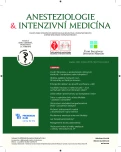Difficult airway management. Three happy ending case reports
Authors:
Horáková Lenka; Hegedüsová Michaela; Kozák Šimon; Vymazal Tomáš
Authors‘ workplace:
KARIM, 2. LF UK, Fakultní nemocnice v Motole
Published in:
Anest. intenziv. Med., 24, 2013, č. 6, s. 380-384
Category:
Anaesthesiology - Case Report
Overview
During routine anaesthesia the incidence of difficult tracheal intubation has been estimated at 3–18 %. Difficulties in intubation have been associated with serious complications, particularly when failed intubation has occurred. Occasionally in a patient with a difficult airway, the anaesthetist is faced with a situation where mask ventilation proves difficult or impossible. This is one of the most critical emergencies that may be faced in the practice of anaesthesia. If the anaesthetist can predict which patients are likely to prove difficult to intubate, he/she may reduce the risk of anaesthesia considerably. These case reports depict possible ways to avoid fatal complications.
Keywords:
difficult tracheal intubation – case report
Sources
1. Wilson, H. I. Prediction and management of difficult tracheal intubation. Practical Procedures, 1998, 9, 9, p. 1–4.
2. Baker, P. A., Flanagan, B. T., Greenland, K. B., Morris, R., Owen, H., Riley, R. H., Runciman, W. B., Scott, D. A., Segal, R., Smithies, W. J., Merry, A. F. Australian and New Zealand College of Anaesthetists. Equipment to manage a difficult airway during anaesthesia. Anaesth Intensive Care, 2011, 39, 1, p. 16–34.
3. McPherson, D., Vaughan, R. S., Wilkes, A. R., Mapleson, W. W., Hodzovic, I. A survey of anaesthetic practice in predicting difficult intubation in UK and Europe. Eur. J. Anaesthesiol., 2012, 29, 5, p. 218–222.
4. Theiler, L., Fischer, H., Voelke, N., Basciani, R., Hasty, F., Greif, R. Survey on controversies in airway management among anesthesiologists in the UK, Austria and Switzerland. Minerva Anestesiol., 2012, 78, 10, p. 1088–1094.
5. Ogilvie, L. Difficult Airway Society guidelines for the management of tracheal extubation. Anaesthesia, 2012, 67, 11, p. 1277–1278.
6. Leeuwenburg, T. J. Access to difficult airway equipment and training for rural GP-anaesthetists in Australia: results of a 2012 survey. Rural Remote Health, 2012, 12, 3, p. 2127.
7. Moreno, M. E., Vera, C. P., Tellería, A. M. The objective structured clinical evaluation of teaching in anaesthesiology and resuscitation. Rev. Esp. Anestesiol. Reanim., 2012, 59, 3, p. 134–141.
8. Fritscherova, S., Adamus, M., Dostalova, K., Koutna, J., Hrabalek, L., Zapletalova, J., Uvizl, R., Janout, J. Can difficult intubation be easily and rapidly predicted? Biomed. Pap. Med. Fac. Univ. Palacky Olomouc Czech Repub, 2011, 155, 2, p. 165–172.
9. Adamus, M., Jor, O., Vavreckova, T., Hrabalek, L., Zapletalova, J., Gabrhelik, T., Tomáškova, J., Janout, V. Inter-observer reproductibility of 15 tests used for predicting difficult intubation. Biomed. Pap. Med. Fac. Univ. Palacky Olomouc Czech Repub, 2011, 155, 3, p. 275–282.
10. Adamus, M., Fritscherova, S., Hrabalek, L., Gabrhelik, T., Zaple-talova, J., Janout, J. Mallampati test as a predictor of laryngoscopic view. Biomed. Pap. Med. Fac. Univ. Palacky Olomouc Czech Repub 2010, 154, 4, p. 339–344.
11. Mallampati, S., Gatt, S., Gugino, S. A clinical sign to predict difficult tracheal intubation: a prospective study. Can. Anaesth. Soc. J., 1985, 32, 4, p. 429–434.
12. Stefan, M., Ciupilan, C., Scutariu, D. M. Study on the association of imaging and clinical anatomic data in the prediction of difficult intubation. Rev. Med. Chir. Soc. Med. Nat. Iasi, 2012, 116, 1, p. 75–82.
13. Han, T., Teissler, H., Han, R., Gaines, J., Nguyen, T. Managing difficult airway in patients with post-burn mentosternal and cicrumoral scar contractures. Int. J. Burns Trauma, 2012, 2, 2, p. 80–85.
14. Isono Shiroh, Ishikawa Teruhiko Oxygenation, Not Intubation, Does Matter. Anesthesiology, 2011,114, p. 7–9.
15. Pacheco, F. A. Phaeohyphomycosis due to Cladosporium cladosporioides. Med. Mycol., 2001, 39, 1, p. 135–137.
16. Schmidt, U., Eikermann, M. Organizational Aspects of Difficult Airway Management: Think Globally, Act Locally. Anesthesiology, 2011, 114, p. 3–6.
Labels
Anaesthesiology, Resuscitation and Inten Intensive Care MedicineArticle was published in
Anaesthesiology and Intensive Care Medicine

2013 Issue 6
Most read in this issue
- Tracheal intubation in intensive care – a life saving or life threathening procedure?
- Difficult airway management. Three happy ending case reports
- Emergence delirium after use of sevofluranein children
- Post-transplant right ventricular failure management
